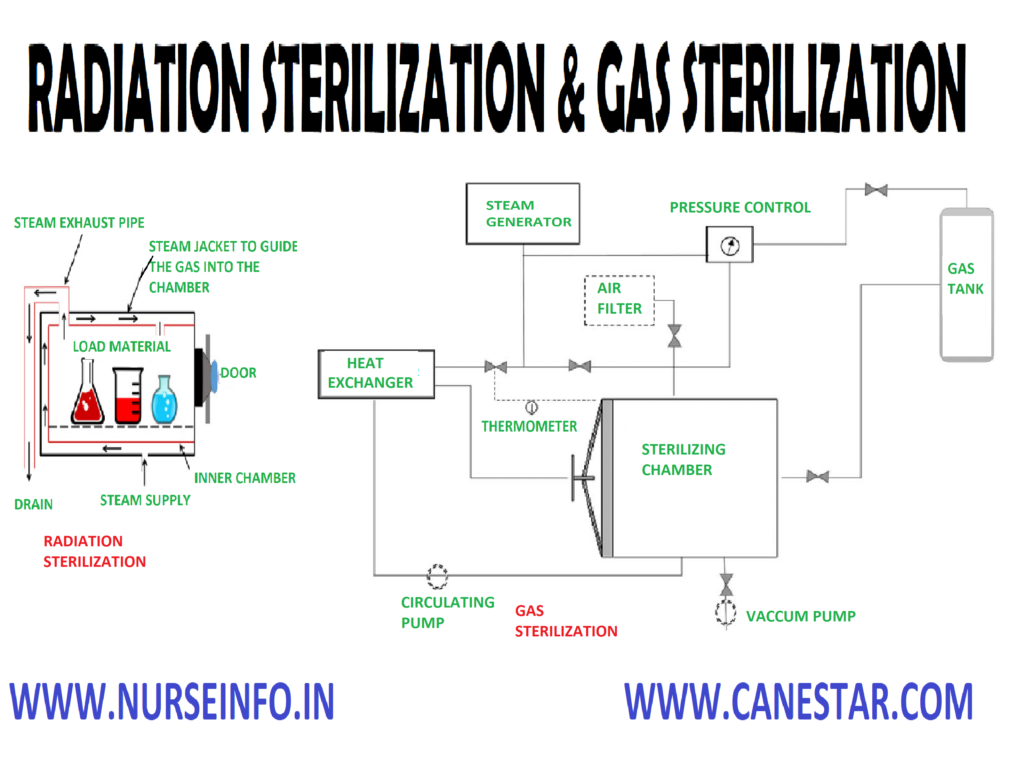Radiation sterilization is a method that uses ionizing radiation, such as gamma rays or electron beams, to eliminate or reduce the microbial load on various products, surfaces, or materials. This process disrupts the DNA and other cellular components of microorganisms, rendering them unable to reproduce or cause infections. Here are key aspects of radiation sterilization:
Types of Ionizing Radiation:
- Gamma Radiation:
- Source: Gamma radiation is often emitted from a radioactive isotope, such as cobalt-60.
- Penetration: Gamma rays penetrate deep into materials, making them suitable for the sterilization of dense or bulky items.
- Application: Commonly used for the sterilization of medical devices, pharmaceuticals, and certain disposable items.
- Electron Beam (E-beam) Radiation:
- Source: E-beam radiation is generated using an electron accelerator.
- Penetration: Electron beams have limited penetration and are suitable for surface sterilization or treating thin materials.
- Application: Used for sterilizing medical devices, packaging materials, and some pharmaceutical products.
Radiation Sterilization Process:
- Preparation:
- Products or items to be sterilized are prepared and packaged appropriately.
- Irradiation:
- The items are exposed to ionizing radiation in a controlled environment, either by gamma radiation from a gamma source or by passing through an electron beam.
- Dose Control:
- The dose of radiation is carefully controlled based on the type of material and the required level of sterilization.
- Dosimetry:
- Dosimeters are used to measure the absorbed dose of radiation, ensuring that the products receive the necessary amount for effective sterilization.
- Post-Irradiation Handling:
- After irradiation, the products are handled carefully to avoid recontamination.
Advantages of Radiation Sterilization:
- Cold Sterilization:
- Radiation sterilization is a cold process, meaning it doesn’t involve high temperatures that could damage heat-sensitive materials.
- Uniform Sterilization:
- Radiation provides uniform sterilization, even in complex or densely packed materials.
- No Residue:
- Unlike some chemical sterilization methods, radiation leaves no residues on the sterilized items.
- Time Efficiency:
- The process is relatively quick, allowing for efficient sterilization on a large scale.
Applications:
- Medical Devices:
- Single-use medical devices, implants, and surgical instruments.
- Pharmaceuticals:
- Sterilization of pharmaceutical products and ingredients.
- Packaging Materials:
- Sterilization of packaging materials for medical and pharmaceutical products.
- Cosmetics:
- Sterilization of cosmetic products to ensure safety and shelf life.
- Food Industry:
- Used for sterilizing certain food products, spices, and packaging materials.
RADIATION STERILIZATION
Radiation or ultraviolet light sterilization: this method is expensive. But nowadays it is used for the sterilization of plastic items such as disposable saline set, catheter, Ryle’s tubes, etc
Gas sterilization: ethylene oxide gas is employed as a sterilizing agent in especially designed chambers in which temperature and humidity can be controlled and from which air can be evacuated
After exposure period of 3 to 6 hours is needed. Other gases employed for sterilization are formaldehyde and betapropiolatone
Articles Sterilized
- Surgical instruments with optical lenses
- Tubing and plastic parts of heart lung machines
- Ventilator tubes
- Disposable syringe
- Pillows and mattresses
Advantages
- Exposure to formaldehyde gas under conditions of controlled humidity, temperature, and the time exposure will destroy all vegetative forms of bacteria, viruses, and most of the spores
- The best results can be obtained with high concentration of gas humidity above 60% and temperature of not less than 180 degree celcius
Disadvantages
- Ethylene oxide has a pungent smell
- It is an irritant to eye, mucous membrane and skin
Radiation Method
There are two type of radiation are non-ionizing radiation and ionizing radiation
Non-ionizing radiation methods are infra-red and ultra-violet radiation
Ionizing radiation methods include X-rays, gamma rays; and cosmic rays are highly lethal to DNA and other vital cell constituents
Advantages
- Instruments like disposable syringe catheters hypo-dermic needles and sharp instruments that cannot withstand heat, can be sterilized by this method
- Instruments which are covered in plastic packs or aluminum foils can be sterilized by this method
Disadvantages
- Since radiation in a straight line and do not penetrate only the surface of an object in straight line is irradiated
- The bacteria in shadows are unaffected, so all the surfaces should be exposed to the radiation


